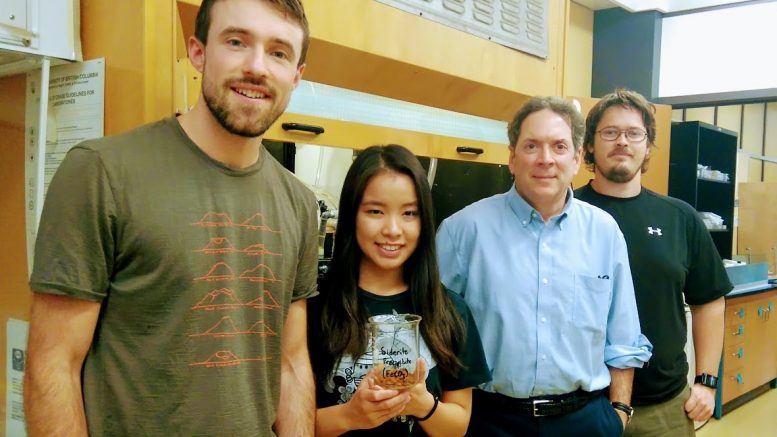VANCOUVER — Lee Groat, a mineralogist and professor from the University of British Columbia, may have just cracked one of mining’s biggest environmental problems — acid rock drainage (ARD) — thanks to initial research funding from Yukon-explorer Strategic Metals (TSXV: SMD).
Groat and his students have found a way to combine acidic water generated from mine tailings with carbon-dioxide from gas emissions to make siderite, a stable iron-carbonate mineral that won’t hurt the environment.
The groundbreaking research has landed Groat and Terra CO2 Technologies, a private research and development company spun-out of Strategic in October, in the semi-finals for the US$7.5-million NRG COSIA Carbon XPRIZE.

Integrated sciences student Andrea Chang adjusting an electrochemical cell in a lab at the University of British Columbia. Credit: University of British Columbia.
The competition encourages the development of technologies that convert carbon gas emissions from a potential liability to something less so.
“The next deadline for submissions is next August, so Terra is looking at places where we can build a pilot plant and scale up the test work,” Groat tells The Northern Miner during a phone interview. “We’ll be scored on how much CO2 we convert, so we’ll see how far we get and give it our best shot. For now we’re all pretty excited.”
Groat doesn’t claim fame to the discovery. He says it was Doug Eaton, president and CEO of Strategic, who first approached him with the idea four years ago.
“Doug called and asked if there was any way to combine tailings with the gases from the generator plant to create something neutral, and he was willing to put up some money for us to play around in the lab,” he says. “At first I wasn’t a believer … if this was actually possible, why hasn’t anyone else done it already?”
And when the orange-coloured mineral precipitated during initial test work, Grout was still puzzled.
“We couldn’t understand why it was precipitating, until one night, a student forgot to plug in the thermocouple, which is used to measure the temperature of the solution. In the morning, nothing had precipitated and we realized that all along, the thermocouple was delivering a tiny bit of electric current — just enough electricity to complete the reaction,” he says.
While the economic implications of the technology will be looked at in more detail next year, Groat says it could vastly lower or eliminate the long-term stewardship costs associated with ARD, which can be enormous.

University of British Columbia professor Lee Groat and his students have found a process to combine acidic water generated from mine tailings with carbon-dioxide from gas emissions to make siderite (seen above), a stable iron-carbonate mineral that won’t hurt the environment. Credit: University of British Columbia.
One such example includes the Faro mine complex in the Yukon, which has a $1-billion price tag from public funds to clean up the site and prevent future ARD from entering the water stream.
Or in Gauteng, South Africa’s richest mineral province, government officials announced plans in May to charge mining companies over US$500 million to clean up the water pollution created by the century-long operations.
Terra’s CEO Dylan Jones says during a phone interview that carbon sequestering could also help offset costs associated with the proposed carbon tax in Canada voiced by Prime Minister Justin Trudeau.
Trudeau’s government proposes to impose a price on carbon emissions at a minimum of $10 per tonne CO2 in 2018, rising to $50 by 2022.
“The amount of carbon or acid a site produces is always going to be different, it depends on the size and nature of the operation,” Jones says. “Some footprints are relatively small, whereas others have huge tonnes per day because they rely on coal, diesel or LNG for power generation, have intensive processing facilities or have a long trucking route.”
For comparison, Gold Fields (NYSE: GFI) stated in a 2009 report that it produced 7.4 million equivalent tonnes CO2 from 3.9 million oz. gold production, or 1.5 tonnes CO2 per equivalent oz. gold. Over 90% of the emissions came from its operations in South Africa, which are largely underground and require energy-demanding ventilation and water pumping infrastructure, compounded with a high South African grid emission factor.
Under Canada’s proposed carbon tax scheme, a company of Gold Field’s size and production profile would theoretically pay up to $370 million in carbon taxes annually.
Jones says the aim for Terra and its UBC partners is to sequester 60 kg — or 30% — of the carbon contained in 2 tonnes of gas exhaust from the upcoming pilot plant study. After this the technology firm would turn to the mining community for strategic partnerships to expand the test work.

Siderite, a stable iron carbonate mineral, can be produced by combining acid rock drainage with CO2 from fuel emissions. Credit: University of British Columbia.


This sounds like a great win – win scenario. One question would be where does the sulphur go and in what form?
Great question Gary, a very astute observation! The sulphur is separated from the iron to produce sulphuric acid, which is potentially a marketable commercial product. Thanks for asking and have a super day!